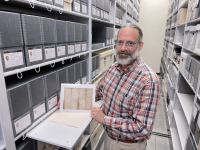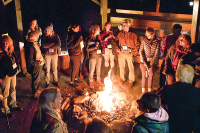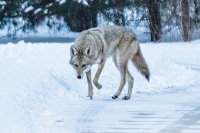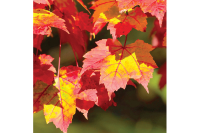As campaign season hits full stride, party loyals double down to turn out the vote
 Sporting a red Obama hat, a matching “Change Rocks” t-shirt and a “Barack Obama 2012” button, Ron Frendreis approached the first house on his list.
Sporting a red Obama hat, a matching “Change Rocks” t-shirt and a “Barack Obama 2012” button, Ron Frendreis approached the first house on his list.
With pen, papers and clipboard in hand, he climbed the concrete steps to a white duplex with fellow campaign volunteer Jane Harrison, knocked on the door marked 82, and then waited.
When an older woman answered, Frendreis greeted her kindly but got straight to the point. He and Harrison wanted to know if she was supporter of President Obama and if she planned to vote in this year’s election.
She answered in the affirmative to both, adding that she had voted consistently for the past 30 years. Amid election-related small talk, Frendreis asked her to sign a card committing to vote on Nov. 6 and handed her a list of other Democratic candidates on this year’s ballot. And with that, they left and headed to house number two.
Frendreis and Harrison are two of the nearly dozen people who gathered at Haywood County’s Democratic Headquarters last Saturday morning to spend the next few hours canvassing — a popular grassroots campaigning effort used by Democrats and Republicans alike to get voters, specifically those with similar viewpoints, to the polls.
Related Items
“The key is mobilizing their base, mobilizing their party,” said Chris Cooper, head of the political science department and director of the Public Policy Institute at Western Carolina University.
During the past couple of elections cycles, campaigns have reverted back to old-time politicking methods, and the phrase “boots on the ground” has quickly become cliché. County-level political parties are becoming increasingly more important to campaign efforts.
“County parties, that is your grassroots,” said David Sawyer, chair of the Swain County and 11th Congressional District GOP. “They are vital to doing the organizing.”
Get out the vote efforts are particularly critical in North Carolina given its status a swing state. North Carolina is seen as a bellwether for the Presidential election. The adage that every vote counts certainly holds true in North Carolina this year, and as a result, national presidential campaigns are taking heed.
Organizing For America, Obama’s grassroots campaign committee, has stationed a paid staffer in Haywood County — one of 40 statewide — to help rally the Democratic troops locally.
As their respective conventions come to a close and November creeps ever closer, Republicans and Democrats are making one giant, two-month-long push for support.
“I think this is the time when campaigns ramp up,” Cooper said. “This is kind of the time the rubber meets the road.”
Both parties locally are using similar tried-and-true tactics, such as phone banking, posting signs and running booths at the county fair to publicize candidates and entice voters to cast a ballot.
More and more, national party leaders at the top are depending on those on the bottom, at the local levels, to make elections successful. Although political ads and smear campaigns won’t be going anywhere, multiple studies have shown that people are more responsive to face-to-face interaction or even a personal phone call than an advertisement they see on television or a robo-email.
“It is much more effective to go door-to-door,” Cooper said. “It is really cheap to send thousands of emails, but it is also not very effective.”
During canvassing, groups of two or three volunteers visit the homes of people affiliated with a specific party or unaffiliated voters who, based on previously collected research or polling, lean a certain way. The main goal is not to campaign for the candidates or convince someone to vote a certain way — but rather to get as many people out to the polls as possible.
With the dawn of the Internet and a more global society, political parties strayed during the past decade from traditional boots-on-the-ground tactics, focusing less on those valuable personal connections and instead funneling their money into large-scale advertising, believing it would make more of a difference because it would reach more people simultaneously.
Despite the seemingly rational logic, national ads specifically aren’t driving people to the polls, whereas person-to-person contact can actually equal additional votes.
“People are sensitive to what is personal and impersonal,” Cooper said. “You don’t feel guilty hanging up on a computer.”
Another reason actual human interaction works is because it’s an invitation from one person to someone in their community to participate, said Chuck Dickson, chair of the Democrat’s “Get Out the Vote” effort in Haywood County and a team leader for Organizing for America.
“People like to be part of something. They like to be invited to do things,” said Dickson, who helped canvas last Saturday.
Local Republican leaders in Haywood, Jackson and Swain counties, meanwhile, have focused their efforts on phone banking and polling.
“We are making a lot of calls,” said John Meinecke, treasurer of the Haywood County Republican Party. “We will start calling people and encouraging them to come out and vote.”
Similar to canvassing, phone banking targets people who have or are likely to vote Republican and is heavily dependent on volunteers. Every week, groups of party loyalist pull up a chair at county Republican headquarters, pick up the phone and run down a list of phone numbers until someone answers.
As soon as the phone clicks and a voice on the other line pipes up in greeting, they are on. The volunteer goes through necessary bullet points, explaining who they are and asking if the individual is willing to take a short survey. At that point, people either respond with a ‘yes’ or with a click of the phone and dial tone.
The volunteer then proceeds with the questions. Who will the person vote for for president — Mitt Romney or Obama? Which candidate for North Carolina governor will he or she pick, Pat McCrory or Walter Dalton? Do they plan to vote for both Romney and McCrory?
At other times, volunteers call Republicans or Republican-leaning voters to ask whether they need someone to drive them to the polls or if they plan to vote early. The idea is to make sure as many Republicans as possible vote.
“You want to have your base,” Sawyer said.
The calls give party organizers a better idea of how many people plan to take part in the election, but it is still hard to know who will actually make the trip to the polls.
“You never know what the weather might be; you never know who will vote early, who will vote on Election Day,” Sawyer said.
Specifically in Jackson County, Republican leaders are helping their candidates obtain billboards for advertising and putting together literature to pass out to voters, Slaughter said.
“In Jackson County, our emphasis is on electing the three M’s and Jim,” Slaughter said, talking about Mark Jones, a candidate for county commissioner; Mark Meadows, a candidate for the U.S. House; Pat McCrory, a gubernatorial candidate; and Jim Davis, the incumbent state senator.
Both Democrats and Republicans are making the rounds at area events, including the aptly timed barrage of county fairs this time of year. The parties set up booths, pass out information about where and when to vote, put in plugs for their respective candidates and answer specific questions from passersby. The booths are an easy way for volunteers to disseminate information to interested people.
And, although their fundraising efforts are limited, county party headquarters will organize fundraisers for candidates leading up to the election and host forums for the candidates to speak at. However, candidates themselves and national level of the political parties devote considerably more time to fundraising.
Early voting: the good and the bad
The rise of early voting has fractured what was once a much simpler, all-encompassing race to the finish line of Election Day. This year, Election Day is not until Nov. 6, but it’s no longer the penultimate date on the calendar circled in red at party campaign headquarters.
Once reserved only for the elderly and disabled, early voting was opened up to the masses in the late 1990s and grew exponentially during the 2000s. By the last presidential election, more than 40 percent of North Carolina’s registered voters cast ballots early.
“Early voting is critical,” Sawyer said. “It is not unusual to see a third or a half of your people voting early.”
That’s led party activist to retool their strategies to account for rolling benchmarks along the way, from the push to get voters registered to the kick-off of early voting, which falls this year on Oct. 18.
Although the results of early voting — namely how someone voted — aren’t tallied until polls close on Election Day, campaign coordinators can monitor who has voted early, obtaining daily lists from the county election board of voters who have been in so far. That cuts down on the number of people they have remind to vote on Election Day.
“Once those votes are in. That’s done,” Sawyer said. “That’s a few thousand people that you won’t have to re-contact on Election Day to make sure they go out and vote.”
It also offers an important first glimpse at how the election is going, though it is not indicative of the outcome.
“Early voting is an early signal — a way to take the temperature of the election but not a good way to diagnose the final outcome,” Cooper said. “High early voting turnout is also a sign of a well-functioning campaign — one that is doing a good job mobilizing voters. And that portends well for Election Day.”
Both political parties and nonpartisan election officials tout early voting as the easier option. Rather than one day, voters have weeks to stop by early voting sites in the county.
During early voting, state residents can register to vote and vote on the same day.
The coveted unaffiliated voter
In order to win an election, a candidate must not only appeal to members of their own party but also a large contingency of unaffiliated voters. In some North Carolina counties, unaffiliated voters can comprise almost one-third of the total registered voters.
But, that doesn’t mean that the unaffiliated don’t identify strongly with one of the political parties.
“Some of those people still vote for one party or another,” Cooper said.
But in the mountains, things can be even more complicated. Some people may be legacy Democrats or Republicans, meaning their family has associated with one party for generations. However, that doesn’t mean they vote for that one party every time or even most of the time.
The mountains are also home to many “Blue Dog Democrats” who are more conservative than the national Democratic Party and sometimes vote with or for Republicans.
“Partisanship works a little differently in the mountains then it does in the rest of the state,” Cooper said.
Because of the unique political climate of the mountains, Republican groups can target their own party loyalists, unaffiliated voters and even dip into the Democratic pool to pick up votes. But, the unaffiliated voter remains both the low-hanging fruit to snag and a critical voting bloc.
“Our emphasis is on the unaffiliated voter, the Republican voter and the conservative Democrat,” said Ralph Slaughter, head of the Jackson County GOP.
Meanwhile, Democratic leaders are appealing to their base of registered Democrats, which outnumber registered Republicans in Haywood, Jackson and Swain counties, as well as the pool of unaffiliated voters.
But, in the end, the only thing that matters is whether or not people vote.
“I think the main thing that has been done by the party, in my opinion, is to emphasize the importance of voting,” said Luke Hyde, head of Swain County’s Democratic Party. “We just think good citizens ought to vote.”
If one or other party fails to get their supporters to the polls, they could easily lose the election, whether they have a larger voter base or not. That is why the grassroots efforts are focusing most of their time on registering voters and encouraging them to go to the polls.
“The important thing is getting the vote out,” Sawyer said.
The volunteers are there to not only to promote their party’s candidates but also to prevent people from forgetting to exercise their right as U.S. citizens.
“A lot of times, it just takes a reminder,” Dickson said.
Campaign trials
Despite today’s technology, reaching out to people during a campaign is still difficult.
The rise of cell phones and the decline in landlines makes it harder to reach voters: there is no such thing as a cell phone book. Unless people willingly divulge their cell phone number when registering to vote, it is hard to come by, and nowadays, more and more people are forgetting about home phones altogether since cell phones have become ubiquitous.
When phone banking, volunteers might find that once-active landline phone numbers, provided back when someone first registered to vote are no longer valid. People might not be home, or they might simply be employing the art of avoidance via caller ID.
And, while a phone call from a campaign volunteer is more personal than a pre-recorded voice message, it is still easier to hang up on someone than to slam a door in his or her face.
“I think phone banking is a little more difficult sometimes” than canvassing, Dickson said.
The biggest problem canvassers face while traveling their pre-mapped routes is not rude or surly residents — in fact, most are at the very least cordial. The hardest part of their job is finding the right address.
“That is always part of the mystery,” said Frendreis, a volunteer who was canvassing on Saturday. “Every now and then, there is an empty lot where a house used to be.”
While canvassing Saturday, Frendreis and Harrison scanned each house looking for the right number. In some cases, the numbers did not line up as one might expect — the right house might be hiding just up a driveway behind another home, or it didn’t have a number at all. That is when canvasser must take their best guess or knock on a door and ask for directions.
“When I rule the world, everyone is going to have numbers on their houses,” Frendreis said.
Voter registration by the numbers
Unaffiliated voters are the difference between winning and losing an election in North Carolina. During the years, the number of registered voters who are not affiliated with any party has continued to grow. Candidates and political parties must duke it out to see who can win the unaffiliated vote, which in some counties can account for nearly one-third of registered voters.
Haywood County
Democrats 19,384
Republicans 12,321
Unaffiliated 10,630
Jackson County
Democrats 11,344
Republicans 7,014
Unaffiliated 8,384
Macon County
Democrats 7,874
Republicans 9,784
Unaffiliated 6,844
Swain County
Democrats 4,375
Republicans 2,595
Unaffiliated 2,998
Important election dates
There are several key dates for voters this election.
First of all, residents must register to vote by Nov. 3. People can register to vote and vote on the same day during the early voting period, which runs from Oct. 18 to Nov. 3
However, after Nov. 3, registered voters must wait until Election Day on Nov. 6 to cast their ballot.













